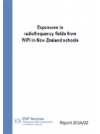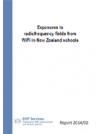This report, commissioned by the Ministry of Health, presents the results of measurements of exposures to radiofrequency (RF) fields from WiFi in two New Zealand schools, both from the access points and devices themselves. The results are compared and supplemented with information from overseas studies.
Key Results
All exposures were very low compared with the public exposure limit in New Zealand Standard 2772.1:1999 Radiofrequency Fields Part 1: Maximum exposure levels 3 kHz - 300 GHz. The maximum exposure averaged over six minutes was equivalent to 0.024% of (i.e. about four thousand times lower than) the reference level specified for the public in that Standard, and generally, in a classroom with a WiFi access point mounted on the wall, time average exposures were less than 0.01% of the limit (ten thousand times lower). In classrooms without an access point, exposures were lower still.
Time average exposures measured 30 cm from a laptop were generally less than 0.001% of the reference level. The results indicate that the duty cycle of devices is typically less than 0.005 (ie the devices transmit for a total of less than 18 seconds inevery hour).
The results from New Zealand are consistent with datapublished by the British Health Protection Agency (HPA, now part of PublicHealth England) and Industry Canada.
Exposures to WiFi signals in New Zealand schools, both from the access points and devices, are very low. On this basis WiFi in schools does not pose a health risk to children or staff.


